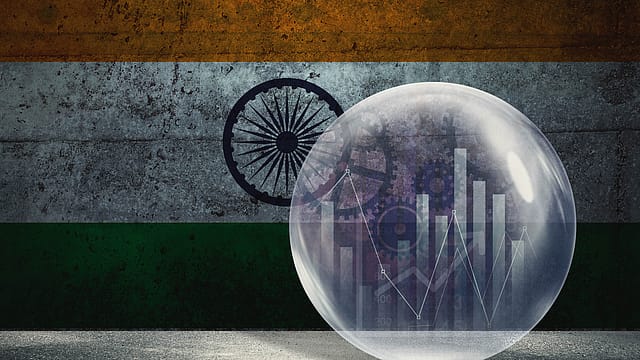India’s internal growth drivers anchor the economy amid U.S. policy shifts: Moody's
ADVERTISEMENT

India is well-positioned to deal with the negative effects of U.S. tariffs and global trade disruptions due to its large domestic economy and low dependence on exports, according to Moody’s Ratings.
Government initiatives to boost private consumption, expand manufacturing capacity and increase infrastructure spending will help offset the weakening outlook for global demand, the ratings agency said. Easing inflation offers the potential for interest rate cuts to further support the economy, even as the banking sector's liquidity facilitates lending, Moody’s explained.
US President Donald Trump's sweeping new tariffs announced on April 2 represent the largest proposed increase in tariffs since the 1930s. Under the so-called “reciprocal tariff” scheme, India faced an additional tariff of 26% for goods exports to the U.S. On April 9, the U.S. administration authorised a 90-day pause on the implementation of most tariffs, reverting to a universal rate of 10% on almost all targeted countries.
The direct trade impact on India is limited, said Moody’s. Even though the U.S. is the single largest export destination for Indian goods, the temporary relief provided by the pause and the smaller portion of goods exports in GDP compared to other emerging markets in Asia-Pacific limit the effects of tariffs on India’s growth, the rating agency said. “We expect 10% universal tariffs and 30% tariffs on most Chinese goods exports to the U.S. will constrain global growth, potentially reducing India’s economic growth in calendar year 2025 to 6.3% from 6.7%. Nonetheless, this growth rate will be the highest among G-20 economies.”
January 2026
Netflix, which has been in India for a decade, has successfully struck a balance between high-class premium content and pricing that attracts a range of customers. Find out how the U.S. streaming giant evolved in India, plus an exclusive interview with CEO Ted Sarandos. Also read about the Best Investments for 2026, and how rising growth and easing inflation will come in handy for finance minister Nirmala Sitharaman as she prepares Budget 2026.
India's key goods exports to the U.S. include electronic goods, textiles, gems and jewellery, pharmaceuticals, machinery and auto parts, and chemicals.
On the recent India-Pakistan tensions, Moody’s said the flare-up earlier in May, would weigh more on Pakistan's growth than on India's. “In a scenario of sustained escalation in localised tensions, we do not expect major disruptions to India's economic activity because it has minimal economic relations with Pakistan. Moreover, the parts of India that produce most of its agricultural and industrial output are geographically distant from the conflict zones,” said Moody’s. However, higher defence spending would potentially weigh on India's fiscal strength and slow its fiscal consolidation, it added.
The Indian government's infrastructure spending supports GDP growth, while personal income tax cuts bolster consumption, Moody’s noted. “India's limited reliance on the trade of goods and its robust service sector are mitigants to U.S. tariffs. India-made goods may even benefit from increased U.S. demand if trade talks lead to lower tariffs on India compared to other emerging markets. Despite global volatility, India's sound banking market and stable credit conditions underscore its economic strength,” it stated.
Strong demand in India for segments like power, transportation and digital infrastructure will continue to attract significant capital investments over next 5-7 years, said Moody’s. The effects of US tariffs will likely be muted for most infrastructure sub-sectors as they cater mostly to domestic demand and benefit from supportive regulatory or contractual arrangements, the ratings agency said.
India’s homegrown demand shields nonfinancial companies against tariffs, according to Moody’s. Significant government investments will boost sectors such as construction, mining and manufacturing, while urbanisation and a young population will fuel demand for housing and consumer goods, it said. However, sectors with exports, like automotives, are exposed to global trade challenges, despite diversified operations.
Moody’s highlighted that Indian companies will remain somewhat insulated from global turmoil, driven by two primary engines: infrastructure development and the country's favorable demographics.
The change in the Reserve Bank of India’s (RBI’s) monetary policy stance to “accommodative” from “neutral” will provide room for further easing in the months to come. Interest rate reductions lower funding costs for companies, increase households’ debt affordability and stimulate overall growth. During the first two monetary policy meetings of the year, the RBI lowered the benchmark repo rate to 6% from 6.5% at the beginning of the year, reflecting easing inflation, slowing economic output and growing trade tensions globally. Headline inflation continued to ease to 3.16% in April, dropping deeper below the RBI’s 4% midpoint target.
The personal income tax cut, announced in the Budget, will mostly benefit urban middle-income households by increasing their disposable income and spending, said Moody’s. “Private consumption has remained steady, accounting for 62% of GDP in April to December 2024, the highest level for the first three quarters of a fiscal year over the past decade. However, demand recovery in urban areas lags behind rural areas, because of stagnant real-wage growth. The tax cut, removing direct tax liabilities for workers earning under $13,860 annually, offers crucial relief to debt-burdened middle-class households and speeds up demand recovery in urban regions,” it said.
